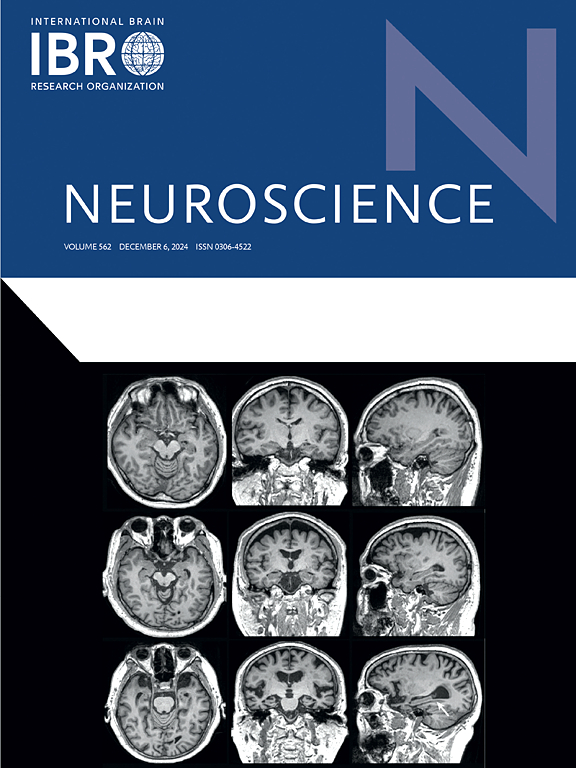IF 2.9
3区 医学
Q2 NEUROSCIENCES
引用次数: 0
摘要
随着对微小核糖核酸(miRNA)研究的深入,人们越来越清楚地认识到,这些小分子在中枢神经系统(CNS)中发挥着至关重要的作用。它们参与了神经元的各种基本功能,特定的 miRNA 在神经系统的不同细胞类型中优先表达。值得注意的是,与其他组织相比,某些 miRNA 在大脑和脊髓中的表达水平更高,这表明它们在中枢神经系统中可能具有专门的功能。与长期神经退行性变化相关的 miRNA 可作为早期治疗决策和疾病监测的重要工具。miR-320、miR-146 和 miR-29 等 miRNA 在神经退行性疾病早期诊断中的意义显而易见,特别是考虑到许多神经和身体症状只有在特定神经元发生实质性退化后才会表现出来。有趣的是,miR-92 和 miR-486 等血清 miRNA 水平可能与多发性硬化症的各种 MRI 参数相关。使用反义策略(如反义 miR-146 和 miR-485)靶向 miRNA 可能比靶向 mRNA 更有优势,因为单个反 miRNA 可调控多个与疾病相关的基因。未来,基于抗miRNA的治疗方法可被纳入神经系统疾病的临床治疗中。某些miRNA,包括miR-223、miR-106、miR-181和miR-146,对各种神经退行性疾病的发病机制有影响,因此值得更多关注。这方面的知识可为鉴定新的诊断、预后和治疗生物标记物铺平道路,并有可能为开发基于 RNA 的治疗策略提供指导。本综述重点介绍了有关 miRNA 在神经系统中作用的最新研究,特别是它们在神经退行性疾病中的保护功能。本文章由计算机程序翻译,如有差异,请以英文原文为准。

microRNAs as molecular tools for brain health: Neuroprotective potential in neurodegenerative disorders
As research on microRNAs (miRNAs) advances, it is becoming increasingly clear that these small molecules play crucial roles in the central nervous system (CNS). They are involved in various essential neuronal functions, with specific miRNAs preferentially expressed in different cell types within the nervous system. Notably, certain miRNAs are found at higher levels in the brain and spinal cord compared to other tissues, suggesting they may have specialized functions in the CNS. miRNAs associated with long-term neurodegenerative changes could serve as valuable tools for early treatment decisions and disease monitoring. The significance of miRNAs such as miR-320, miR-146 and miR-29 in the early diagnosis of neurodegenerative disorders becomes evident, especially considering that many neurological and physical symptoms manifest only after substantial degeneration of specific neurons. Interestingly, serum miRNA levels such as miR-92 and miR-486 may correlate with various MRI parameters in multiple sclerosis. Targeting miRNAs using antisense strategies, such as antisense miR-146 and miR-485, may provide advantages over targeting mRNAs, as a single anti-miRNA can regulate multiple disease-related genes. In the future, anti-miRNA-based therapeutic approaches could be integrated into the clinical management of neurological diseases. Certain miRNAs, including miR-223, miR-106, miR-181, and miR-146, contribute to the pathogenesis of various neurodegenerative diseases and thus warrant greater attention. This knowledge could pave the way for the identification of new diagnostic, prognostic, and theranostic biomarkers, and potentially guiding the development of RNA-based therapeutic strategies. This review highlights recent research on the roles of miRNAs in the nervous system, particularly their protective functions in neurodegenerative disorders.
求助全文
通过发布文献求助,成功后即可免费获取论文全文。
去求助
来源期刊

Neuroscience
医学-神经科学
CiteScore
6.20
自引率
0.00%
发文量
394
审稿时长
52 days
期刊介绍:
Neuroscience publishes papers describing the results of original research on any aspect of the scientific study of the nervous system. Any paper, however short, will be considered for publication provided that it reports significant, new and carefully confirmed findings with full experimental details.
 求助内容:
求助内容: 应助结果提醒方式:
应助结果提醒方式:


